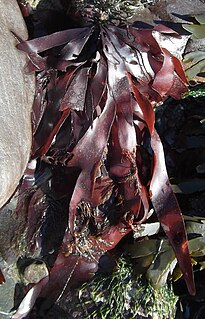
Palmaria palmata, also called dulse, dillisk or dilsk, red dulse, sea lettuce flakes, or creathnach, is a red alga (Rhodophyta) previously referred to as Rhodymenia palmata. It grows on the northern coasts of the Atlantic and Pacific Oceans. It is a well-known snack food. In Iceland, where it is known as söl, it has been an important source of dietary fiber throughout the centuries.

Ascophyllum nodosum is a large, common cold water seaweed or brown alga (Phaeophyceae) in the family Fucaceae, being the only species in the genus Ascophyllum. It is a seaweed that only grows in the northern Atlantic Ocean, also known in localities as feamainn bhuí, rockweed, Norwegian kelp, knotted kelp, knotted wrack or egg wrack. It is common on the north-western coast of Europe including east Greenland and the north-eastern coast of North America, its range further south of these latitudes being limited by warmer ocean waters.

Polysiphonia is a genus of filamentous red algae with about 19 species on the coasts of the British Isles and about 200 species worldwide, including Crete in Greece, Antarctica and Greenland. Its members are known by a number of common names. It is in the order Ceramiales and family Rhodomelaceae.
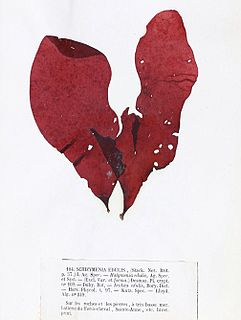
Dilsea carnosa, commonly known as the poor man's weather glass or the sea belt, is a species of red algae in the Dumontiaceae family of the order Gigartinales.
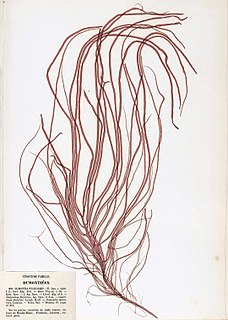
Dumontia contorta is a relatively small epiphytic algae of the sea-shore.
Polysiphonia atlantica is a small filamentous species of red marine algae Rhodophyta. The thalli form small tufts up to 3 cm long. The axes are ecorticate consisting of axial cells surrounded by four periaxial cells.
Polysiphonia brodiei (Dillwyn) Sprengel, now generally spelled "brodiaei", as it is named after James Brodie is a species of red algae in the Rhodophyta. It grows in tufts up to 36 cm long.

Polysiphonia ceramiaeformis, also called banded siphon weed, is a small red algae (Rhodophyta), in the genus Polysiphonia. Individuals are irregularly branched with the branches extending up to 5.5 centimetres (2.2 in) from a central node and ending in dense tufts of fibres.
Polysiphonia denudata is a small red alga, Rhodophyta, growing as tufts up to 20 cm long without a main branch axis.
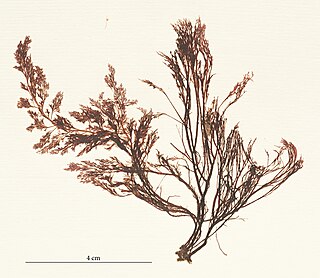
Polysiphonia elongata is a small red marine algae in the Rhodophyta.
Polysiphonia fibrata is a species of Polysiphonia that grows as small dense tufted and finely branched marine alga in the Rhodophyta.
Polysiphonia furcellata (C.Agardh) Harvey is small marine red alga in the Division Rhodophyta.

Choreocolax polysiphoniae is a minute marine parasitic alga in the division Rhodophyta.
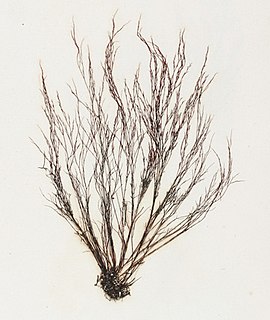
Polysiphonia nigra is a species of marine alga in the division Rhodophyta.
Polysiphonia opaca (C.Agardh) Moris et De Notaris is a small marine alga in the division Rhodophyta.

Polysiphonia stricta is a small red marine alga in the Division Rhodophyta.
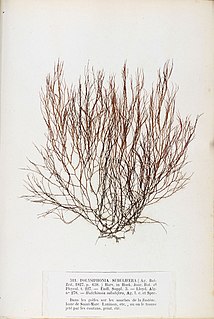
Vertebrata subulifera is rather small marine alga in the division Rhodophyta.

Gymnogongrus griffithsiae is a small uncommon seaweed.
Gastroclonium reflexum is a small red marine seaweed.
Chylocladia verticillata is a medium-sized red marine alga.














